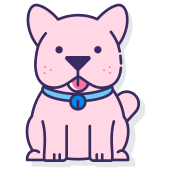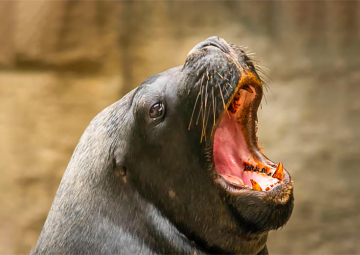GENERAL
Basket Training and Conditioning of the Giant Pacific Octopus

My name is Melanie Johnson, I am Senior Aquarist for Fish and Invertebrates at the Georgia Aquarium in Atlanta. I grew up in someplace you would never think an aspiring marine biologist would grow roots: Phoenix, Arizona (Think of the hottest place on Earth, its probably a little hotter than that…probably).
My life and career has been somewhat unconventional. I spent 6 years as a Military Police Officer in the U.S. Army National Guard, and in 2015 after my service I happened upon a part time job as an Educator for a small public aquarium. As many people can probably relate, there is a certain “calming fascination” that ocean animals bring, and I quickly became enthralled with learning everything about them.
Marine invertebrates especially captured my interest, in that they seemed to exist in these tiny obscure worlds that were so easy to overlook, and yet so complicated in their own dynamic behaviors.
One of the invertebrates that quickly captured my intrigue for its charismatic nature is the giant pacific octopus (GPO). Cephalopods (which consist of squid, cuttlefish, octopus, and nautilus)- are notoriously distinguished as a charismatic group of animals that show advanced- and usually strange - adaptive behaviors and an uncharacteristic inquisitiveness for a mollusk/invertebrate. Giant pacific octopuses are the largest species of octopus, and as an animal with no protective body armor and rich in tasty proteins and nutrients, they have had to develop some extraordinary observational skills to “outsmart” any potential predators. I’ve worked with 7 GPO’s in various stages of their lifecycles, and every one of them has taught me a little more about the intricacies of their intelligence.
Color/Texturizations for reference.
Note: Individuals may display unique behaviors, and observations are based purely on the octopuses I have worked with personally
Under human care, public aquariums tend to direct animal enrichment and training towards two subjects: encouraging natural behaviors that an animal would display throughout its life, and conditioning to decrease stress during necessary medical/interventional procedures. With octopuses, one of the best ways to provide good husbandry is to condition them to “Basket Training”. In simple terms- asking the octopus to voluntarily enter an enclosed space by reinforcing the activity with all the things octopuses love best: Toys, Food, and Fun! That way if they ever need to be transported, examined by medical staff, or morphometrics collected to monitor their growth and diet- the process becomes exponentially less scary (because trying to FORCE an octopus to do just about anything is nearly impossible… they are very strong and clever).

Smooth, large blotches of color usually indicate great interest in the activity or toy. I think of the color patches like a “slight attempt to camouflage”, while most of the attention is focused on the interesting activity.
Like with all animals, before I start any training or enrichment I spend time “getting to know” the individual, which allows me to make approximations about their behavior. Many animals require a customized approach to training, because just like us- each individual is unique. The more you learn about them, the more you can set them up for success, and I think that’s important to always keep in mind. When working with an animal that is non-vocal and quiet- you must pay especially close attention to how they communicate with you, and the way octopuses do it is simply magnificent. Through tiny color-changing cells (chromatophores) and muscle-flexing fibers (papillae), they can communicate emotional complexities through movements, color changing, and skin textures. And caring for them opens a door to a “reference sheet” into their cognitive process, by simply observing the color/texture behaviors of that individual.
Understanding the disposition of the individual, you can new formulate training milestones for the octopus based on their comfort and willingness to learn. With basket training, I usually spend several sessions desensitizing the octopus to the new (big and scary!) thing near its exhibit, and reinforce its curiosity or tolerance with a food or toy. Most octopuses are naturally curious, and if they are especially brave and come over to investigate the basket, I reinforce their curiosity with a jackpot! of food.

Smooth, deep reds are a sign of comfort and excitement. A GPO will often turn deep red before pouncing to the surface, indicating they are eager to engage with you.
These processes take a lot of consistency, time, and patience- but in return reinforces a bond of trust between the octopus and you that will make them more resilient to changes throughout their lifecycle. In animal training, we use an expression known as a “trust bank”, which means that as long as you make “positive deposits” 95% of the time, the 5% that you must take out of the bank will have a minimal impact on the animal’s trust and wellbeing.
Having no backbone or exoskeleton has its perks for an octopus! These animals LOVE to squeeze into small spaces, and so placing them in a transport container or basket is not hugely stressful to this cephalopod if you have conditioned them positively. I have even found that some of the octopuses I work with tend to prefer staying in a basket, and will often drag them down into their exhibits even after the training session has ended (and as a two-armed mammal I stand no chance against them in tug-o-war).

Fine specking and exaggerated textures is a sign of uncertainty/caution, and actively camouflaging in case there is danger. When displaying this behavior, I will often pause the session to allow the octopus to become more comfortable.
The final phase in basket training is to be able to lift the basket and octopus completely out of water, allowing Animal Care Staff to conduct transports and animal weight. If you’ve done everything right up until this point, the GPO will sit as a patient blob at the bottom of the basket until you resubmerge them once again. I would like to add, that while I always advice against lifting fish out of water (it harms their sensitive gills), octopuses are especially evolved to tolerate brief periods out of water while they hunt for prey in shallow tidal pools. It’s a classic example of why understanding the natural history of the animals you care for is absolutely essential for good husbandry practices.
The nature of an octopus (who- might I remind- has no natural defenses except analyzing, ink, and camouflage) is to behave unpredictably and outsmart everyone. So understandably no training plan goes 100% how you would expect it. Working with undomesticated animals means you should always prepare for the unexpected, but a good Aquarist knows how to make a plan to deviate from! And in the same way that the Hawaiian Day Octopus forms mutualistic teamwork with the Manybar Goatfish- octopuses will quickly learn that their caretakers are on their team, and become willing to collaborate in pursuit of food and enrichment. It’s one of the many reasons the Giant Pacific Octopus will always have a special place in my heart.

Octopus has claimed basket after training session has ended, and brings its toys into the new “den”.
A huge thank you to WeZooit for allowing me to share a snapshot into the obscure world of octopus training, and for being the platform to allow scientists and storytellers to inspire the adoration, wonder, and preservation of our natural world.
Melanie Johnson
The Professional Octopus Cuddler


















